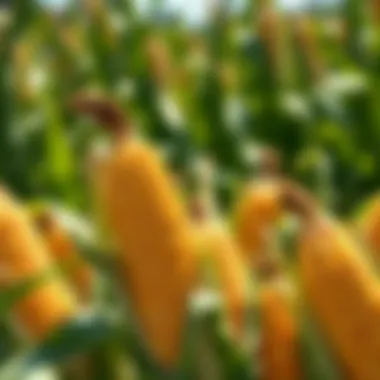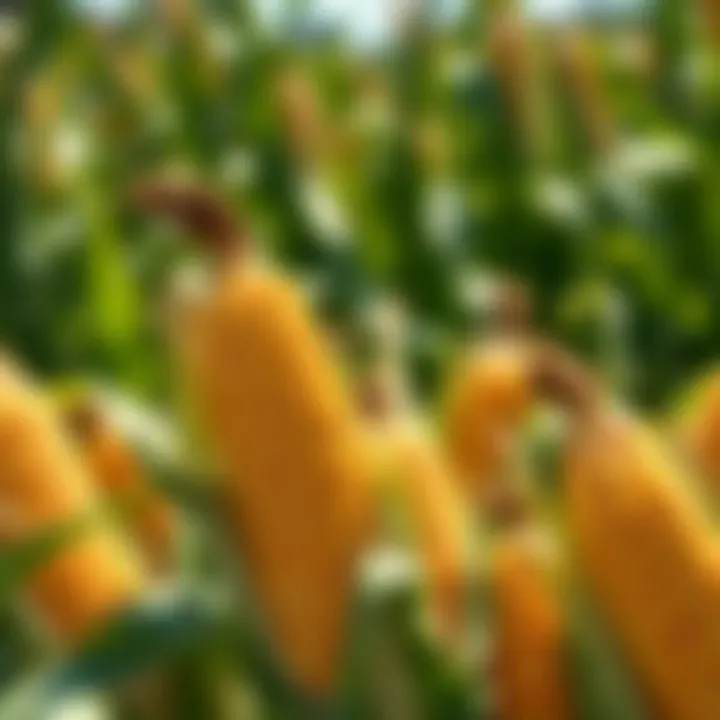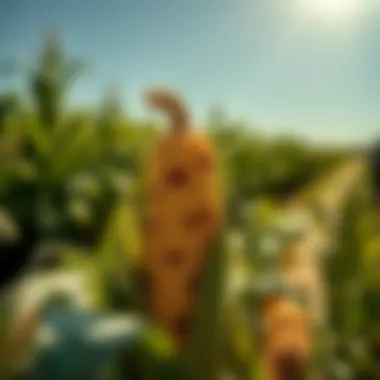Analyzing Corn Put Option Prices in Agriculture


Topic Overview
Definition and Importance
Corn put options are financial contracts that grant the buyer the right, but not the obligation, to sell a specified amount of corn at a predetermined price before a certain expiration date. They serve as a form of risk management for both producers and traders in the agricultural commodities market. For farmers, purchasing put options can act as an insurance policy against falling corn prices, ensuring they can maintain a certain level of profit for their harvest. For traders, these options allow for strategic maneuvers in a volatile market, enabling them to hedge against price drops while potentially profiting from fluctuations.
Understanding these instruments is crucial for anyone involved in corn trading or farming. By grasping the mechanics behind put options, stakeholders can better navigate the complexities of the commodities market. This knowledge can lead to more informed decisions when it comes to pricing, managing risks, and maximizing profits.
Brief History and Evolution
Corn trading has roots that stretch far back into human history, but the use of options is a more recent development. The introduction of futures and options contracts in the mid-20th century revolutionized how commodities were traded. In the early days, transactions were more straightforward, with farmers directly negotiating sales based on prevailing market conditions. However, as the market became more sophisticated, it evolved into the intricate financial landscape we see today.
During the 1970s, options trading began to gain traction, allowing for more flexible strategies that adapted to rapidly changing market conditions. The Chicago Board of Trade (CBOT) played a vital role in standardizing the trading of corn options, facilitating a marketplace where both buyers and sellers could operate with a level of confidence previously unseen. The evolution of electronic trading systems in the late 20th and early 21st centuries further accelerated this trend, making these financial instruments more accessible to a broader audience.
Key Techniques and Innovations
Sustainable Farming Practices
Farmers increasingly recognize the importance of sustainable practices. These methods not only contribute to environmental preservation but can also affect corn prices indirectly. When farmers engage in practices such as crop rotation or reduced chemical usage, they may enhance their crop yields without the over-reliance on costly inputs. This can stabilize corn production and, subsequently, pricing in the market, which can influence put option pricing.
Advanced Agronomic Technologies
With the rise of agri-tech, farmers now have access to data analytics, seed technology, and precision farming tools. These innovations allow for better crop monitoring and resource management. For instance, data collected through sensors can help a farmer decide the best timing to market their corn or when to exercise put options based on real-time market conditions. Understanding these technologies is crucial for farmers aiming to make strategic decisions that align with their risk management strategies.
Practical Applications
Step-by-Step Guides
- Identify Your Risks: Understand the specific risks associated with corn production, such as market volatility and climate impacts.
- Choose the Right Put Option: Research various put options available for corn and assess which one aligns with your financial goals and risk tolerance.
- Set a Strategy: Develop a strategy around when to exercise your put options or sell them back in the market. Timing is everything here.
- Monitor Market Conditions: Keep an eye on market trends and corn prices, adjusting your strategy as necessary.
Case Studies or Real-World Examples
In the 2020 agricultural year, corn prices were subject to volatility due to trade issues and shifting weather patterns. Farmers who adopted put options during this period often found themselves in a safer position. For example, consider a farmer who purchased a put option when prices were at $4.00 per bushel. As market conditions worsened and prices fell to $3.50, the farmer was able to minimize losses by exercising the option, effectively ensuring a minimum return on their crop. Such real-world examples illustrate the practical usefulness of options in safeguarding against market downturns.
"Corn put options can protect you from price swings, but they require careful planning and timing."
In summary, grasping the nuances of corn put option prices, their historical context, and practical applications can empower agricultural investors to make savvy, informed choices in a competitive market. Understanding these aspects is not just beneficial—it's vital for success.
Preface to Corn Put Options
In the intricate world of agricultural finance, understanding corn put options stands out as a crucial aspect for farmers and investors alike. The corn market, being one of the backbone commodities of agriculture, often experiences significant fluctuations, which can pose both risks and opportunities. This section sets the stage by elucidating the essence of put options and their pivotal role in managing these market risks.
When one talks about put options, it’s essential to grasp their function. A put option is a financial contract that gives the holder the right, but not the obligation, to sell a specified amount of an underlying asset—here, corn—at a predetermined price within a set timeframe. This flexibility serves as a hedge against potential declines in corn prices, while also allowing for potential profit when market conditions are favorable.
Definition of Put Options
Put options can be a bit tricky at first glance. In a nutshell, they are insurance in the context of corn trading. When corn prices tumble, farmers holding a put option can sell their corn at the strike price rather than at market price, thus reducing their losses. For example, if a farmer sells a put option with a strike price of $4.00 per bushel, and the market price drops to $3.50, they can still sell their corn at $4.00. This helps in maintaining profitability even when the market swings in an unfavorable direction.
Understanding this concept becomes particularly significant as it allows farmers and investors to make more informed decisions. Instead of reacting emotionally to price changes, they can devise strategies grounded in a clearer understanding of their vulnerabilities and potential gains.
The Role of Options in Agriculture
The importance of options in agriculture cannot be overstated. They are akin to a farmer's safety net. In a business as risky as agriculture, where weather conditions, trade policies, and global markets dictate prices, put options offer a mechanism for risk management. For instance, the global demand for corn can shift rapidly due to economic conditions or changing dietary preferences. A dramatic change in demand can lead to sudden price drops, causing significant financial strain for farmers. Put options mitigate this risk by allowing producers to lock in prices ahead of time.
To illustrate, consider the case of a Midwestern corn farmer facing a potential drought. With uncertainty looming, the farmer could purchase put options on their expected yield. If prices fall, they still have a buffer. On the flip side, they can remain poised to capitalize should prices rise, ensuring a balanced approach towards maximizing profits while minimizing exposure to losses.
In summary, exploring corn put options within the agricultural market isn't merely an academic endeavor; it’s a practical avenue for navigating risk and enhancing profitability. It paints a fuller picture of how farmers and investors can utilize tools like options in their strategic arsenal, ultimately leading to a more resilient agricultural sector.
Key Takeaway: Emphasizing the relevance of corn put options transcends mere definitions; it highlights the strategies that empower producers to withstand market volatilities efficiently.
Market Overview of Corn Trading
Corn is not merely a staple food; it plays a crucial role in the global agricultural market. It is one of the most traded commodities worldwide, influencing various sectors from livestock feed to biofuels. When discussing the market overview of corn trading, we must comprehend why corn's price dynamics matter not just for farmers but also for investors, food producers, and consumers alike. The corn market's health is a reflection of larger economic conditions and consumer behavior, making it essential to grasp its intricate workings.
Importance of Corn in Agriculture
Corn, or maize as it is known in some parts, is often dubbed the "queen of grains". It’s grown on every continent except Antarctica, underpinning food security and economic stability in many regions. The significance of corn goes beyond mere consumption; it is pivotal in various sectors such as:
- Livestock Feed: A substantial portion of corn is used for animal feed. This impacts poultry, dairy, and meat production.
- Biofuels: Corn is a primary source for ethanol production, which is increasingly vital in the renewable energy sector.
- Food Products: Beyond corn on the cob, it finds its way into countless food products, from corn syrup to tortillas.
- Exportation: For countries like the United States, corn exports are a vital source of foreign exchange, affecting national economies.
The interplay of supply and demand, both locally and globally, directly influences market prices. Therefore, understanding corn trading is fundamental for all stakeholders involved in its lifecycle.
Historical Pricing Trends
The history of corn pricing is a study of shifting trends influenced by various factors, including economic events and climate change. Prices have demonstrated volatility driven by market speculation, changes in agricultural production practices, and international trade policies. Key historical trends include:
- Price Increases in Crisis Times: Historical data shows significant price surges during economic crises or adverse weather events, such as droughts or floods, which limit supply.
- Technological Advances: The introduction of genetically modified organisms (GMOs) in the 1990s led to drastic increases in yield per acre. As a result, periods of oversupply often followed, leading to drops in prices.
- Global Market Integration: The 21st century has seen an increased interdependence of global markets. Events in one part of the world can send ripples, impacting corn prices far beyond local borders. For instance, a drought in Brazil could create upward pressure on corn prices in Europe or North America.
Tracking these historical trends provides insight into future market movements. Historical pricing data helps investors and farmers make informed decisions about planting, selling, and hedging strategies. Understanding these patterns can also assist stakeholders in assessing risk levels in their investment approaches.
"Understanding corn's historical pricing trends is not just about looking back; it’s a compass pointing toward future market strides.”
By looking at both the importance of corn in agriculture and its historical pricing trends, stakeholders can navigate the often turbulent waters of corn trading with a more informed and strategic approach.


Understanding Put Option Pricing
Understanding put option pricing is pivotal for anyone involved in agricultural commodities, especially when it comes to corn. This section dissects the layers of pricing mechanisms that dictate how put options are valued. Grasping these concepts enables farmers and investors to more effectively manage risks, make better trading decisions, and potentially improve profitability.
Key Components of Pricing
Several elements contribute to the pricing of corn put options, and neglecting any can result in an incomplete picture. The principal factors typically include:
- Underlying Asset Price: The current price of corn is a major influence. If market prices drop below the strike price of the option, the value of the put option increases.
- Strike Price: This is the predetermined price at which the holder can sell the underlying asset. Choosing an appropriate strike price aligns with one’s risk tolerance and market outlook.
- Time to Expiration: As the expiration date of the option approaches, time value diminishes. This phenomenon is often called time decay, and it varies across different market conditions.
- Interest Rates: Fluctuating interest rates can alter the cost of holding an options position, subsequently influencing pricing.
- Volatility: This refers to the expected fluctuations in corn prices. Higher volatility generally leads to higher option prices as the uncertainty increases potential outcomes.
Understanding these constituents can make the difference between a savvy investment and an ill-timed bet. Remember, it’s about looking at the big picture.
Impact of Market Volatility
Market volatility stands out as one of the most crucial influencers in the pricing of corn put options. When volatility is high, traders expect significant price movements, which can make put options more appealing. Here’s how:
- Increased Demand for Protection: In volatile markets, farmers and traders alike may seek to hedge against sharp price declines. This heightened demand can artificially inflate put option prices.
- Perceived Risk: If corn prices are likely to swing wildly—due to unforeseen factors like geopolitical tensions or abrupt weather shifts—investors may be more inclined to purchase options as a safeguard against loss.
- Market Sentiment: An upsurge in market sentiment about impending volatility can create a ripple effect, leading to increased activity in the options market. Investors and farmers begin to price in their protective measures more actively.
On the other hand, during periods of low volatility, the opposite occurs. Investors become less willing to pay a premium for protection, leading to a drop in put option prices. Understanding this interplay between volatility and pricing is paramount for making informed decisions.
Factors Influencing Corn Put Option Prices
Understanding the factors influencing corn put option prices is crucial for anyone engaging with the agricultural commodities market. These factors not only define the pricing of corn put options but also elucidate the underlying market dynamics that drive investment decisions. When farmers and investors grasp these elements, they can make informed choices that align with their risk management strategies.
Supply and Demand Dynamics
The law of supply and demand is a foundational concept in economics with significant implications for corn put options. When the supply of corn surges due to a bountiful harvest, prices generally take a nosedive. Conversely, if a drought hits and supply drops, prices often escalate. This fluctuation directly affects put option pricing.
In practical terms, let’s say a farmer expects a bumper corn crop and anticipates lower prices. He might purchase a put option to hedge against a potential drop in price below a certain threshold. Therefore, understanding these supply dynamics allows traders to gauge the market sentiment more accurately.
Here are some key points regarding supply and demand:
- An increase in corn production can lead to falling prices, increasing the appeal of put options.
- Seasonal patterns often dictate supply levels. For instance, the fall harvest season can result in price volatility as supply enters the market.
- Shifts in consumer demand, like increasing interest in corn for biofuels, can complicate these dynamics further.
Geopolitical Events
Geopolitical events can also swing market dynamics significantly, leading to various outcomes for corn put option pricing. Trade wars, sanctions, or changes in agricultural policy can alter market perceptions and realities profoundly. For instance, if a significant corn-exporting country faces political instability, it might disrupt supply lines, pushing prices up due to perceived scarcity.
Consider the U.S.-China trade relations. When tariffs are applied on corns, the market might react with hesitation, driving put option values higher as investors brace for potential falls in prices. Here are some factors to consider regarding geopolitical impacts:
- Trade negotiations and agreements can sway corn prices dramatically.
- Sanctions against major corn producers can create panic in the market, influencing options trading.
- Political ties influencing agricultural exports may lead to unpredictability in future pricing, thereby impacting strategy for corn traders.
Weather Patterns and Climate Effects
Weather is often the wild card in agriculture. Unpredictable conditions can severely impact crop yields, thus influencing corn put option prices. Severe weather events, such as floods or droughts, can substantially affect supply, leading to price spikes that directly tie back to how put options are valued.
Investors must keep an eye on meteorological forecasts. For example, forecasts predicting a brutal drought could lead to an uptick in corn prices, prompting farmers to buy put options to safeguard against potential losses. Important considerations relating to weather patterns include:
- Normal weather conditions typically contribute to stable pricing, while erratic conditions can lead to wild price fluctuations.
- Long-term climate changes are causing shifts in growing seasons, which can affect supply chain expectations.
- Monitoring weather patterns can be a vital aspect of formulating an effective risk management strategy in trading corn put options.
"The unpredictability of climate impacts farmers’ decisions, which can render a simple market analysis insufficient for understanding corn futures."
These factors collectively underscore the importance of a nuanced understanding of market dynamics in corn trading. By considering supply and demand metrics, geopolitical climate, and weather influences, investors can better navigate the complexities of corn put options and their pricing.
Evaluating Put Options in Trading Strategies
When stakeholders in the agriculture sector, such as farmers and investors, contemplate how to effectively navigate the often-turbulent waters of corn pricing, put options emerge as a key tool. This section will lay bare the tactical nuances of evaluating put options within trading strategies. The ultimate aim is to show how these strategies can mitigate risks or amplify profits in an unpredictable market.
Hedging Against Price Declines
Hedging is akin to wearing a raincoat on a forecast-hazy day. You might not be sure whether the skies will open up, but it pays to be prepared. In the agricultural space, where market dynamics can shift faster than a corn stalk can sway in the wind, put options serve as a safety net.
For instance, a farmer anticipating a harvest of corn could purchase put options at a fixed price. If the market price of corn tumbles before he sells his harvest, these options allow him to sell his corn at the pre-set price, thus protecting his investment. It’s a powerful tactic—essentially buying insurance for your crops.
Consider these elements:
- Risk Mitigation: Farmers can shield their profits from downward market trends.
- Flexibility: If market conditions improve, they can simply choose not to exercise their put options and sell at a higher spot price instead.
- Financial Stability: This kind of strategic risk management helps maintain a steady cash flow, ensuring that farmers can weather the storm of adverse price movements.
However, while hedging is beneficial, it's crucial to not overlook the potential costs associated. Premiums must be paid for the options, which can eat into profits if not well calculated.
"In options trading, not all premiums are created equal. You must weigh the costs against your level of comfort with risk."
Speculation and Profit Opportunities
On the flip side, we have speculation, which is fundamentally different from hedging. While the latter seeks to protect, speculation dives headfirst into the waves with the ambition of reaping rewards. For savvy investors who are willing to take on more risk, put options can unlock avenues for significant profits.
In this scenario, an investor might buy put options if they believe corn prices are destined for a fall. If their predictions come to fruition, they can sell the put options at a far greater price. The difference between the buying and selling prices can lead to commendable gains. Here are key considerations:
- Market Analysis: Successful speculation hinges heavily on accurate market forecasts, thus requiring extensive analysis of pricing trends, demand fluctuations, and other indicators.
- Timely Execution: Timing is critical. Investors need to act quickly, as options have expiration dates, and the market can turn on a dime.
- Research Tools: Utilizing technology and data analytics can enhance decision-making, providing insights that unearthing opportunities often requires. This is where platforms like Reddit and data aggregation sites can offer invaluable community knowledge and insights.
Comparative Analysis with Other Commodities
A comparative analysis of corn put options with other commodities, like soybeans and wheat, is vital for grasping the nuanced dynamics of the agricultural options market. Understanding how corn options relate to these other commodity options enriches the perspective on risk management and investment strategies. Each commodity has its own unique set of factors that influence pricing, making it essential for anyone involved in trading to know these distinctions and similarities. As corn sits at the center of many agricultural markets, analyzing its options against soybeans and wheat can yield important insights for producers, traders, and investors alike.


Corn vs. Soybean Options
When we line up corn options next to soybean options, we see some striking contrasts and a few similarities. Corn is often the go-to crop for animal feed, and thus its pricing can be sensitive to livestock market demands. Soybeans, on the other hand, cater to both the animal feed market and the burgeoning vegetable oil market. This dual demand means that soy options often reflect varying economic pressures.
For instance, when the livestock sector is booming, one might see corn prices hold firm or climb, while soybeans are affected differently based on oil production needs. Conversely, during periods where biofuel production ramps up, corn options may spike in value, providing a hedge against price increases in related fields. While corn and soybeans both depend on weather patterns and global market conditions, they can diverge significantly based on acute, specific disruptions in demand or supply.
A deeper dive into soybean prices reveals that they are often seen as a less risky investment compared to corn, mostly because of their diversified use. This can make soybean options more attractive to traders looking for stability. On the other side, corn options can attract those willing to navigate higher volatility for potentially greater rewards.
Corn vs. Wheat Options
Switching gears to wheat, this commodity brings a whole new flavor into our comparative analysis. While corn serves primarily as animal feed and ethanol source, wheat is the staple grain consumed directly by humans worldwide. This fundamental distinction leads to different market influences, where wheat options can be significantly affected by geopolitical tensions and global trade policies that may not impact corn options in the same way.
Wheat's pricing can be affected by conditions like trade tariffs or export bans, which are particularly detrimental when nations involved are large producers. For example, if a country like Russia enacts wheat export restrictions, this creates ripples across global wheat prices, while corn may remain relatively unaffected unless the restrictions tie into global feed supply.
In terms of options pricing, wheat tends to exhibit less volatility than corn, primarily due to the regular supply and demand for human consumption. Therefore, investors interested in options on wheat may find them appealing for hedging lower-risk strategies. Meanwhile, corn options might present an opportunity for those who are prepared to take a chance with higher risk.
In summary, even though these agricultural commodities interact within the broader market, understanding their unique characteristics creates better-informed traders and investors. The comparative analysis of corn, soybeans, and wheat options highlights essential strategies and responses to market changes.
Practical Examples of Corn Put Options
When dealing with corn put options, real-world applications paint a vivid picture of their significance in managing the risks associated with price fluctuations. This section digs into pertinent examples that underscore the practical consequences of employing these options for farmers and traders alike. Understanding these scenarios helps demystify the operational advantages and the broader context in which these instruments function.
Case Study: Successful Hedging
Consider a corn farmer in Illinois who dabbles in put options as part of a comprehensive risk management strategy. Suppose the farmer expects a bumper crop due to favorable weather conditions, yet fears the price could plummet by harvest time. In response to market volatility, they decide to purchase put options at a strike price of $5 per bushel, set to expire shortly after the harvest.
As harvest time approaches, the corn prices indeed begin to dip, driven by unexpected oversupply in the market. However, due to the put option, the farmer has the right to sell their corn at $5 per bushel, regardless of the market price. When the dust settles, with the market price dropping to $4.50, this put option effectively ensures that the farmer can reclaim $5 per bushel, thus securing a safety net for their investment and shielding themselves from potential losses.
This scenario illustrates how strategically placed put options can serve as a safety valve, allowing farmers to navigate market uncertainty while still capitalizing on the hard work invested in their crops.
"Hedging is not a gamble; it is a calculated approach to mitigating risk, securing one's future in unpredictable climates.”
Analysis of a Failed Speculation Attempt
Not every attempt to use corn put options ends in success. A cautionary tale involves a speculative trader who, enticed by market rumors of rising prices, decided to aggressively bet against the market by writing put options. Their strategy leaned heavily on the belief that prices would soar due to a new demand surge from international markets.
Initially, things looked promising, and prices did inch upward. However, unforeseen geopolitical tensions arose, leading to a market crash. The price of corn plummeted to $3.75, falling well below the option thresholds that the trader had assumed would remain stable. As the markets spiraled downwards, the trader not only lost a significant amount of money but also faced the obligation to buy corn at the set strike prices from the option holders—adding insult to injury.
Overall, this story serves as a sobering reminder that while corn put options can offer potent risk management tools, they also come with the inherent risk of loss, especially when leveraged without sufficient due diligence.
These cases illustrate the dual-edged nature of corn put options—when approached with a clear strategy, they can be immensely beneficial in hedging risks, but they can also lead to significant financial setbacks when used recklessly.
Risks Associated with Using Put Options
When dealing in corn put options, understanding the risks involved is as crucial as knowing the potential rewards. These risks can affect not just individual traders but the broader agricultural community as well. With the nature of options trading, especially in commodities like corn, it's essential to approach the subject with a keen awareness of the potential pitfalls. This section dives into two main risks: market risk and liquidity risk, shedding light on their implications for traders and investors alike.
Market Risk
Market risk, often simply referred to as price risk, is the most apparent hazard in trading put options. This risk pertains to the fluctuations in market prices that can significantly influence the value of an option. In the world of corn trading, market risk is particularly prominent due to various factors affecting the corn market, including supply and demand imbalances, changes in consumer behavior, and broader economic trends.
Typically, as the market price of corn falls, the value of a put option increases, providing a form of insurance for the holder. However, if the price does not fall as anticipated or if it rises, the trader may face losses.
Factors that contribute to market risk include:
- Unexpected weather conditions: Droughts or floods can drastically alter corn production, impacting prices unpredictably.
- Changing regulations: New agricultural policies can affect prices. If regulations favor certain crops over corn, this can lead to a drop in corn prices.
- Economic indicators: Global economic health can impact commodity prices, with inflation, interest rates, and exchange rates all playing a role.
In light of these factors, traders need robust strategies to mitigate market risk. One such strategy may involve diversifying holdings and employing options spread techniques, which can help cushion potential blowbacks from adverse price movements.
Liquidity Risk
Liquidity risk, on the other hand, addresses the potential difficulty in buying or selling an asset—here, a put option. It refers to the risk that a trader may not be able to easily unwind a position without significantly impacting the price at which the option can be sold. This kind of risk is particularly high in commodity markets like corn, where trading volumes can vary greatly.
When liquidity is low, options may struggle to find buyers at a reasonable price. This can occur for several reasons:
- Market participation: During off-peak seasons or times of uncertainty, the number of active traders may dwindle, leading to lower liquidity.
- Complex option structures: Some options have intricate characteristics that can deter investors, causing lower trading volumes and widening bid-ask spreads.
- High volatility periods: Sudden price spikes or drops can deter participants, as many are hesitant to enter uncertain markets.
In situations marked by low liquidity, a trader may be forced to sell at a less favorable price, which amplifies the losses from market risk. Thus, opting for liquid corn put options can foster ease of execution, making it vital to check the market volume before engaging.
"The ability to either buy or sell quickly can be the difference between a profitable and unprofitable trade, particularly in the dynamic environment of corn options."
In summary, market risk and liquidity risk represent significant considerations for corn put option traders. Recognizing and preparing for these risks can aid traders in navigating the complexities of options trading, ultimately leading to more informed and strategic investment decisions. By being aware of potential pitfalls and adopting sound risk management techniques, investors can better position themselves for success in the corn futures markets.
Legislative Impacts on Options Trading
The realm of options trading, particularly when it comes to agricultural commodities like corn, is intricately woven into the legislative fabric that governs financial markets. Understanding these legislative impacts is crucial for stakeholders, such as farmers and investors, who navigate this landscape to manage risk effectively. Legislation influences everything from trading practices to market structure and investor protection.
Regulatory Framework
In the United States, options trading is primarily regulated by the Commodity Futures Trading Commission (CFTC) and the Securities and Exchange Commission (SEC). The CFTC oversees futures and options related to commodities, including agricultural products, while the SEC regulates options on securities. This regulatory framework aims to ensure market integrity and protect traders from fraudulent activities.
Key regulations put forth by these bodies include the Dodd-Frank Wall Street Reform and Consumer Protection Act, which emerged in response to the 2008 financial crisis. This act mandates greater transparency and risk management protocols among trading firms. Moreover, it emphasizes the importance of clearinghouses in transactions to mitigate counterparty risk.
"Establishing and adhering to a robust regulatory framework is fundamental for maintaining confidence in the trading system."


Benefits of Understanding Regulatory Framework:
- Ensures compliance, reducing the likelihood of legal conflicts.
- Encourages strategic planning in trading activities.
- Enhances awareness of market risks and protections.
It's equally important to note that each state may impose its own set of rules, adding another layer of complexity that traders must navigate. Depending on where they operate, traders can find a mixed compliance landscape that can affect their trading activities in corn put options specifically.
Recent Policy Changes
Legislative bodies are constantly revisiting the rules governing options trading to adapt to changing market dynamics. Recent policy changes have put greater emphasis on risk management and investor education. For instance, there has been a movement toward requiring trading firms to enhance their technological infrastructure to handle big data efficiently. This shift underscores the growing importance of data analytics in predicting market trends and making informed decisions.
In addition, there's been a constructive dialogue around the volatility of agricultural commodity pricing caused by external pressures like trade wars and climate change. Changes in legislation have aimed to enhance market resilience against such shocks.
Furthermore, as environmental concerns gain traction, policies are evolving to promote sustainable trading practices. Initiatives that reward environmentally friendly practices in agriculture are slowly integrating into trading frameworks, impacting corn option valuations.
Considerations Regarding Recent Policy Changes:
- Awareness of changes can provide a competitive edge in trading strategies.
- Policy shifts can directly impact put option valuations, necessitating frequent assessments.
- Staying informed ensures that traders remain compliant and competitive in an evolving marketplace.
Technological Advancements in Trading
The landscape of trading has undergone seismic shifts in recent years, thanks largely to technology. For traders dealing in commodities like corn, these advancements are not just nice-to-have features; they form the backbone of decision-making processes. Technology enhances accuracy, speeds up transactions, and opens the door to wide-ranging analytical tools that were once beyond reach. But what really makes these advancements noteworthy?
With the surge in algorithmic trading, market transactions are executed based on complex mathematical models. Traders can now set algorithms to recognize patterns, making it possible to buy or sell options in mere milliseconds, a task that would take a human far longer. This not only leads to better pricing but also affects the volatility and liquidity of the markets. The implications are immense; trading corn put options can now be more predictable and efficient than ever.
Algorithmic Trading in Options
Algorithmic trading refers to the use of algorithms to execute orders based on a specific set of criteria. In the world of corn put options, this means that traders can factor in various market signals and execute trades that align with their portfolio strategies without human intervention. It lowers the chance for emotional decisions that could lead to market mistakes.
- Speed: Algorithms can analyze vast amounts of data in seconds, pinpointing optimal buying or selling opportunities.
- Accuracy: Less room for human error, which can be particularly vital in volatile markets.
- Efficiency: Trades happen at lightning speed, ensuring that traders can take advantage of fleeting market conditions, ultimately improving profit margins.
The jargons related to algorithmic strategies might sound daunting, yet they are shaping the future of options trading. For example, traders might use a mean-reversion approach to predict when the market will cool off after a hot streak or recognize significant price dips to capitalize on post-corrections in corn prices.
Use of Data Analytics
The world is awash with data, and agricultural trading is no exception. Data analytics is a game-changer, providing traders with insights into market behaviors, historical price patterns, and predictive modeling. For corn traders, this might involve examining past weather data, geopolitical insights, or even consumer demand studies, all synthesized into meaningful projections.
- Predictive Analysis: Helps traders understand future price movements by analyzing past data trends. With machine learning, traders can now predict potential downturns or spikes far more accurately.
- Risk Assessment: Understanding risk is crucial. Advanced analytics can help in identifying risk factors tied to crop yields, international trade policies or market trends, thus aiding farmers and investors in making well-informed choices.
- Enhanced Decision Making: With dashboards displaying real-time analytics, traders can visualize market dynamics and adjust their strategies effectively.
Data-heavy insights pave the way for more informed trading decisions. For instance, when a weather anomaly is detected, such as an unexpected frost in a key corn-producing region, data analytics can quickly gauge the potential market impact. Armed with this insight, traders can position their put options accordingly, ensuring they safeguard their investments.
"Understanding data is one of the linchpins in today's agricultural trading markets. Those who leverage analytics are often the ones who come out on top."
In essence, technological advancements create an environment where efficiency, speed, and accuracy are the norms, rather than the exceptions. And as traders navigate through corn put options, staying updated on these technologies can mean the difference between thriving and just surviving. Armed with this tech-savvy knowledge, traders can pivot, adapt, and ultimately excel in the complex world of corn options trading.
For further reading on algorithmic trading and data analytics in finance, you might find these resources useful:
- Wikipedia on Algorithmic Trading
- Investopedia on Data Analytics
- National Agricultural Statistics Service for agricultural data.
Future Trends in Corn Put Options
Understanding the future trends in corn put options is crucial for farmers and investors alike. These trends provide insight into how the agricultural landscape may shift, impacting not just pricing but also risk management strategies. With technology, policy changes, and global events playing pivotal roles, monitoring these developments can turn potential challenges into profitable opportunities.
Predicted Market Developments
The corn market is likely to evolve due to several foundational changes. First, technological advances in agriculture, such as precision farming and the adoption of data analytics, are expected to revolutionize crop yield predictions. As farmers increasingly rely on real-time data, the fluctuations in supply and demand could transform how put options are priced. For instance, if yield predictions become more accurate, it could lessen the perceived risk associated with price drops, impacting put option premiums.
Additionally, geopolitical factors will continue to shape the corn market. Ongoing trade negotiations and tariffs can disrupt traditional trading patterns, causing volatility in pricing. As the relationship between major corn-exporting and importing countries changes, traders must stay agile, adjusting their strategies accordingly.
Another critical factor lies in climactic shifts. Climate change is not just a distant concern; extreme weather events are becoming more common. Droughts, floods, and unpredictable seasons heavily influence corn yields and subsequently, put option pricing. Understanding weather patterns will be vital for farmers and investors as they develop their risk management plans.
"Being informed of the market's changes is not just wise; it’s essential for survival in the agri-business world."
Strategies for Adaptation
As the market evolves, so too must the strategies employed by both farmers and investors. Here are prudent strategies to adapt:
- Diversification of Investments: Rather than putting all eggs in one basket, consider diversifying across various crops and commodities. This hedging approach can provide a buffer against potential losses in corn prices.
- Leveraging Technology: Utilizing agricultural apps and trading platforms can help adapt to real-time market changes. Tools that provide insights into weather predictions and market trends should become an integral part of your toolbox.
- Enhanced Risk Management Techniques: Implementing multi-tiered risk strategies can buffer against price volatility. Combining corn put options with other hedges allows for a secure footing when markets turn sour.
- Continuous Education and Networking: Join agricultural forums and attend seminars to learn more about the latest trends. Surrounding yourself with knowledgeable individuals in the industry can refine your strategy and keep you ahead of the curve.
By focusing on these strategies and regularly assessing the market's developments, farmers and investors can not only protect their investments but also position themselves for potential profit. As unpredictable as the market may seem, having a clear understanding of future trends and crafting informed strategies can spell the difference between mere survival and thriving in the complex world of agricultural finance.
Ending and Key Takeaways
In the realm of agricultural finance, comprehending the dynamics of corn put option prices stands as a pivotal skill for both farmers and investors. As we examined throughout this article, put options offer a valuable mechanism for hedging against adverse price movements and allow investors to speculate on corn market trends with a strategic edge. Let's summarize the critical elements that define the importance of this topic:
The Importance of Understanding Options
Understanding corn put options is akin to gaining control over a robust financial tool. Here are some noteworthy aspects:
- Risk Management: By utilizing put options, farmers can safeguard their revenue against price drops, ensuring they can cover costs and maintain profitability even in volatile conditions.
- Market Insight: Options trading is often reflective of market sentiment. By analyzing put option prices, investors can glean insights into expected future price movements, allowing for more informed decision-making.
- Strategy Flexibility: Options provide a variety of strategies that can be employed depending on the individual risk tolerance and market outlook. From basic hedging to complex strategies, the options market allows for customization based on unique circumstances.
"The key to options trading lies not merely in grasping their functionalities, but in understanding how they interact with broader market signals."
Recommendations for Farmers and Investors
To navigate the complexities of corn put options effectively, it is essential to embrace the following recommendations:
- Continuous Education: Given the evolving nature of market dynamics, staying updated with ongoing agricultural policies and market trends is crucial. Websites like USDA.gov provide valuable resources for understanding the implications of government policies on crop prices.
- Utilize Data Analytics: Farmers and investors should invest in analytical tools to monitor market trends. Platforms offering data on historical pricing can significantly enhance decision-making processes.
- Consult Industry Experts: Engaging with financial advisors or agricultural economists can provide tailored guidance that accounts for a specific operational context. Networking through forums like Reddit can also open doors to valuable insights from seasoned professionals and peers.
- Practice Caution: While options present opportunities, they also come with risks. Individuals should assess their own situation and risk tolerance thoroughly before diving into options trading.
Finally, it's imperative for both farmers and investors to appreciate that the market is influenced not only by supply and demand, but by geopolitical events and climatic changes as well. By incorporating these insights and strategies into their approaches, stakeholders in the corn market can cultivate resilience and adaptability within the constantly changing agricultural landscape.



